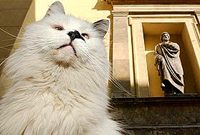08.21.2004 16:19
 That makes Vaska and about 50 fellow cats valuable allies in preserving one of the world's most renowned collections.
That makes Vaska and about 50 fellow cats valuable allies in preserving one of the world's most renowned collections.
Cats have been part of the Hermitage museum's security system since its founding days. Catherine the Great, the empress who started the collection in 1764, brought in selected cats to try to keep the building rodent-free.
Today's crew of felines lives in the basement, cared for by two museum employees and barred from the exhibit halls lest they leap onto a canvas or display pedestal.
However, Vaska, at age 12 the oldest of the cats, has figured out how to sneak in.
His usual destination is the Pavilion Hall, one of the museum's most popular rooms, which holds the elaborate gilded Peacock Clock.
"He usually does it on Mondays, when the museum is closed to visitors, and unnerves the museum's security, who have to rush into the Pavilion Hall when Vaska sets off the alarm system," said Tatyana Danilova, deputy head of the museum's supervisors.
Vaska will not have any offspring to inherit the secret of his route – Hermitage cats are neutered to keep their numbers manageable.
"However, we still get new cats," said Galina Lukinova, of the cat corps' caretaker. "Since people know that we take care of them in the Hermitage they either abandon them on the territory of the museum or bring them in when their owners die."
To keep the balance, however, the Hermitage also advertises its cats for adoption, including on the Internet.
The Hermitage cats usually dine on fish, chicken liver, porridge and tinned food twice a day.
"The Hermitage does not have enough mice and rats to feed all the cats," Lukinova said.
News source: signonsandiego.com
 Print this news Print this news
Culture news archive for 21 August' 2004.
Culture news archive for August' 2004.
Culture news archive for 2004 year.
|